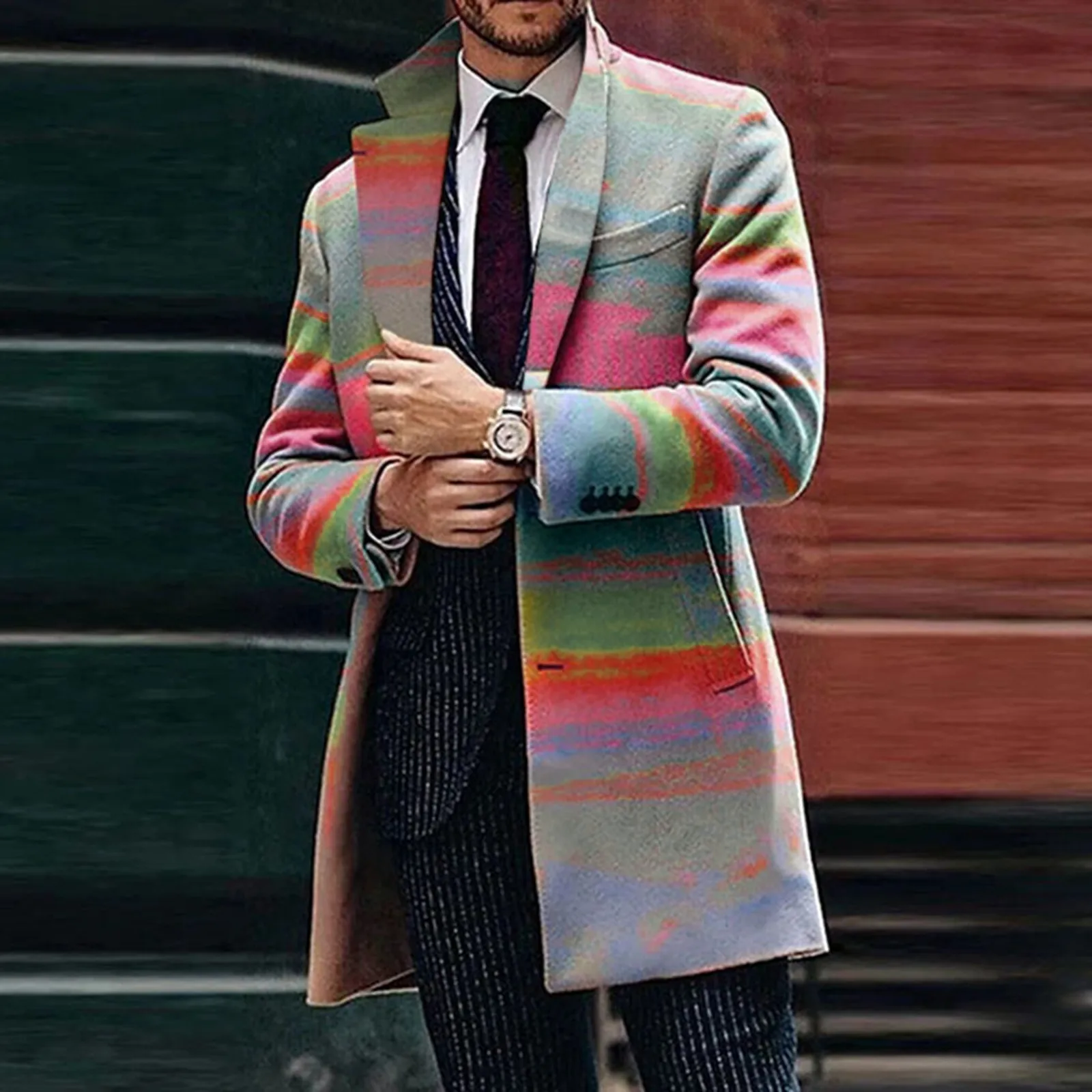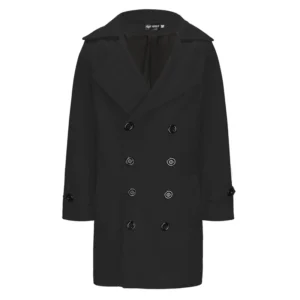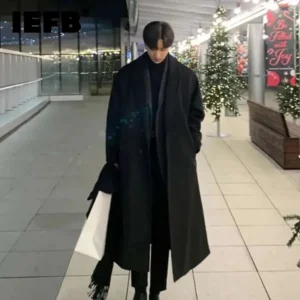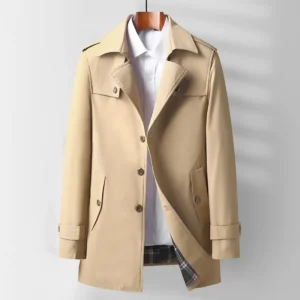Understanding the Ideal Light Topcoat for Layering
When discussing light topcoats, we’re not just talking about physical weight, but a combination of qualities that make these garments exceptional for layering. A truly “light” topcoat balances refined appearance with practical wearability through thoughtful material selection and construction.
The ideal light topcoat for layering features:
- Material density: Lighter fabrics (12-16 oz) versus traditional heavy wool topcoats (25-30 oz)
- Strategic construction: Less internal structure and canvassing to reduce bulk
- Thoughtful lining choices: Partial lining or lightweight materials that don’t add unnecessary weight
- Precision cut: Allowing room for layers without appearing oversized
The value of light topcoats becomes especially apparent during transitional seasons when temperatures fluctuate throughout the day. Unlike their heavier overcoat cousins that extend below the knee and feature more substantial construction, topcoats hit mid-thigh to just above the knee, offering protection without overwhelming your frame.
Understanding foundational knowledge about coat length principles helps when selecting the perfect layering piece. The right topcoat creates a refined silhouette while accommodating everything from a dress shirt to a chunky sweater or blazer underneath.
For truly versatile layering, the coat must maintain structure without rigidity. This delicate balance allows the garment to drape elegantly over various underlayers while still providing a clean, tailored appearance. Explore our collection of various topcoat options for layering to find the perfect balance for your needs.
Essential Fabrics for Lightweight Layering
The fabric of your topcoat determines not just its weight but also its drape, breathability, and overall layering performance. For optimal layering capability, certain materials stand out for their particular qualities.
Natural Fibers:
– Lightweight Wool (13-16 oz): The gold standard for light topcoats, offering natural temperature regulation and excellent drape. Merino and tropical wool varieties provide exceptional softness and reduced weight.
– Cashmere and Wool-Cashmere Blends: Delivering remarkable warmth despite their lighter weight (typically 12-14 oz per yard), these luxurious options provide unparalleled softness and elegant drape over layers.
– Cotton and Cotton Blends: Ideal for mild weather, cotton gabardine and twill (10-12 oz per yard) provide structure with less insulation, making them perfect for early fall or spring layering.
Technical and Performance Fabrics:
– Wool-Synthetic Blends: Adding small percentages of synthetic fibers (5-10%) to wool can improve wrinkle resistance and durability without compromising breathability.
– Performance Wool: Treated natural fibers offering water and stain resistance while maintaining the breathability wool is known for.
– Technical Synthetics: Advanced polyester and nylon blends (8-10 oz) with remarkable water resistance and minimal weight, though they may not drape as elegantly as natural fibers.
The weight-to-warmth ratio is particularly important for layering pieces. A well-constructed 14 oz wool topcoat can provide more effective insulation than a poorly made 20 oz option while allowing greater freedom of movement and more comfortable layering.
For versatile options that maintain elegant appearance while supporting layering, consider our selection of wool blend options ideal for lightweight layering. These carefully crafted blends combine the best properties of multiple materials for optimal performance.
Optimal Construction and Design Elements
The construction of your topcoat significantly impacts its layering capability, regardless of fabric quality. Several key design elements determine whether a topcoat will layer beautifully or bunch uncomfortably over your other garments.
Shoulder Construction Options:
– Raglan shoulders: Offer the most layering flexibility, with sleeve seams extending from underarm to neckline, eliminating shoulder restriction
– Natural shoulders: Feature minimal padding and a softer construction that contours to underlying layers
– Roped shoulders: Provide structure but require more precise sizing to accommodate layers
Topcoat Closure Styles:
– Single-breasted designs: Provide cleaner lines and greater versatility for most layering situations
– Double-breasted options: Offer additional warmth but require more careful sizing to accommodate layers without distortion
Lining Considerations:
– Partial lining: Covers only the upper back and sleeves, reducing bulk while maintaining shape
– Full silk or bemberg lining: Allows for smooth layering over wool suits or textured sweaters
– Unlined options: Provide maximum flexibility but may sacrifice some structure
The ideal topcoat length for layering typically hits just above the knee, providing coverage without restricting movement. This length ensures proper proportion while accommodating layers underneath. For more specific guidance, our detailed guidance on appropriate coat lengths provides comprehensive information based on body type and height.
Internal construction elements like floating chest pieces (rather than fully fused fronts) allow the coat to mold better to your body and layers over time. Meanwhile, higher armholes combined with properly cut sleeves enable comfortable arm movement even with multiple layers underneath.
Fit Considerations for Perfect Layering
Finding the perfect fit for a layering topcoat requires balancing room for underlayers while maintaining a refined silhouette. Unlike standard coats, layering topcoats need strategic space in key areas without appearing oversized.
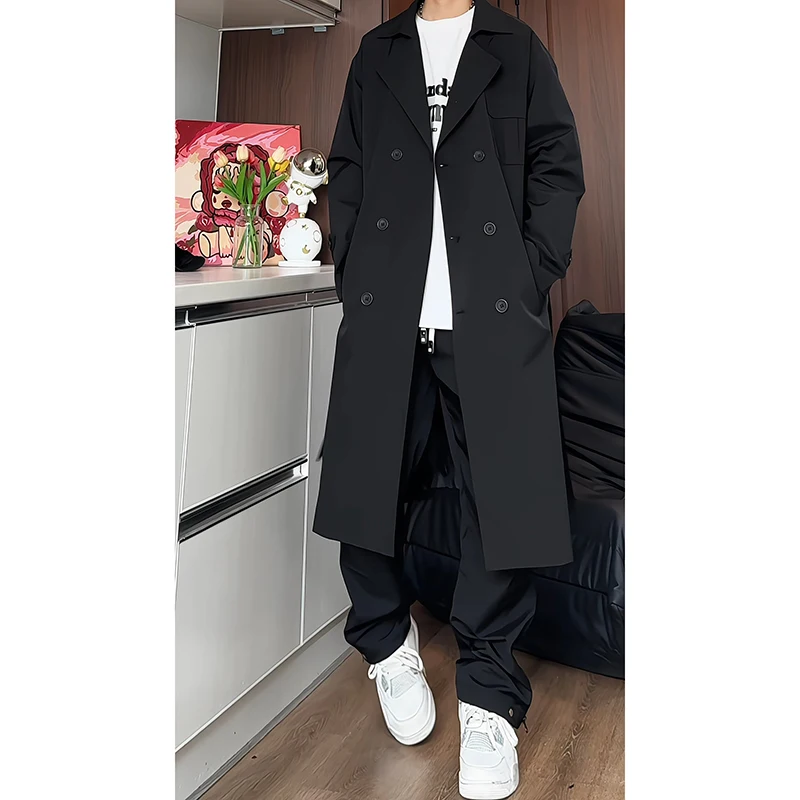
Essential Fit Elements:
– Chest allowance: Aim for 4-6 inches (10-15 cm) of extra room beyond your chest measurement to accommodate suits and sweaters
– Shoulder width: Should extend approximately 0.5 inches (1.25 cm) beyond your natural shoulder to allow for layers
– Sleeve length: Ideally 0.5-0.75 inches (1.25-2 cm) longer than your suit jacket sleeve to protect underlayers
– Overall length: Should hit at mid-thigh to just above the knee for optimal proportion
When trying on a potential layering topcoat, wear your typical layering garments—whether that’s a suit, sport coat, or heavy sweater. This real-world test reveals potential issues with movement or fit that might not be apparent when wearing just a shirt.
Movement Tests for Proper Fit:
1. Button the coat completely and extend your arms forward
2. Cross your arms across your chest
3. Sit down to ensure no uncomfortable pulling or bunching
Common fit mistakes include buying your exact suit size (too tight for layering) or going too large (creating a shapeless appearance). Instead, most men should consider going up exactly one size from their suit jacket size for optimal layering capability.
Alterations can significantly improve a topcoat’s layering ability, particularly sleeve adjustments and minor waist suppression to maintain shape while providing room. For guidance on how coat length affects your overall appearance, explore our advice on selecting length for a flattering silhouette.
Top 5 Light Men’s Topcoats for Layering in 2025
After analyzing dozens of options across various price points and styles, these five topcoats represent the best combination of quality, layering capability, and versatile styling options.
1. The Metropolitan Cashmere-Wool Blend Topcoat
This exceptional coat features a 90% wool, 10% cashmere blend at 14 oz weight, providing remarkable warmth without bulk. The half-canvassed construction with natural shoulders creates an elegant silhouette while accommodating everything from dress shirts to medium-weight suits.
Key Features:
– Three-button single-breasted design
– Partial butterfly lining in cupro
– Notch lapel with moderate width
– Two flap pockets plus ticket pocket
Ideal For: Business professionals seeking versatile wear from fall through early spring
2. The Lightweight Technical Wool Chesterfield
This innovative coat combines traditional styling with modern performance features. Crafted from 16 oz performance wool with water-resistant treatment, it features classic Chesterfield details with a contemporary fit perfect for layering over business and casual wear alike.
Key Features:
– Velvet collar with traditional Chesterfield design
– Water-repellent wool treatment
– Center vent for movement
– Slightly roomier cut specifically designed for layering
Ideal For: The urban professional navigating unpredictable weather conditions
3. The Essential Merino Topcoat
This minimalist design proves that simplicity often yields the greatest versatility. Made from 13 oz merino wool, this coat offers exceptional drape over multiple layers while maintaining a clean, contemporary silhouette.
Key Features:
– Clean front with concealed placket
– Raglan shoulders for maximum layering flexibility
– Unlined body with sleeve lining only
– Notch lapel and flap pockets
Ideal For: Minimalist wardrobes seeking maximum versatility
4. The All-Season Cotton-Wool Blend Topcoat
This innovative 12 oz cotton-wool blend (70% cotton, 30% wool) creates a topcoat that transitions perfectly between seasons. The lighter construction makes it ideal for layering in mild conditions or worn open over multiple layers in cooler weather.
Key Features:
– Two-button front with notch lapel
– Quarterlined construction
– Natural shoulders with minimal structure
– Side vents for movement and layering flexibility
Ideal For: Temperate climates and transitional season wear
5. The Classic Gabardine Trench Topcoat
This refined take on the trench coat silhouette utilizes a lightweight 10 oz cotton gabardine that’s perfect for layering. The adjustable features allow customization based on your underlayers.
Key Features:
– Removable liner for seasonal adaptability
– Adjustable belted waist
– Raglan sleeves for maximum range of motion
– Water-resistant treatment
Ideal For: Rainy climates and business travelers seeking versatility
| Topcoat Model | Fabric Weight | Layering Capacity | Price Range | Best For |
|---|---|---|---|---|
| Metropolitan Cashmere-Wool | 14 oz | Suit/Heavy Sweater | $$$$ | Business/Formal |
| Technical Wool Chesterfield | 16 oz | Medium Suit/Sweater | $$$ | Urban/Versatile |
| Essential Merino | 13 oz | Light Blazer/Sweater | $$$ | Minimalist/Casual |
| Cotton-Wool Blend | 12 oz | Light Layers/Shirt | $$ | Mild Weather |
| Gabardine Trench | 10 oz | Variable w/Liner | $$$ | Travel/Rain |
For additional excellent layering options with traditional styling, explore our collection of wool overcoats with excellent layering capabilities.
How to Choose Your Perfect Light Layering Topcoat
Selecting the ideal topcoat for your specific layering needs requires evaluating several personal factors, from your local climate to your existing wardrobe.
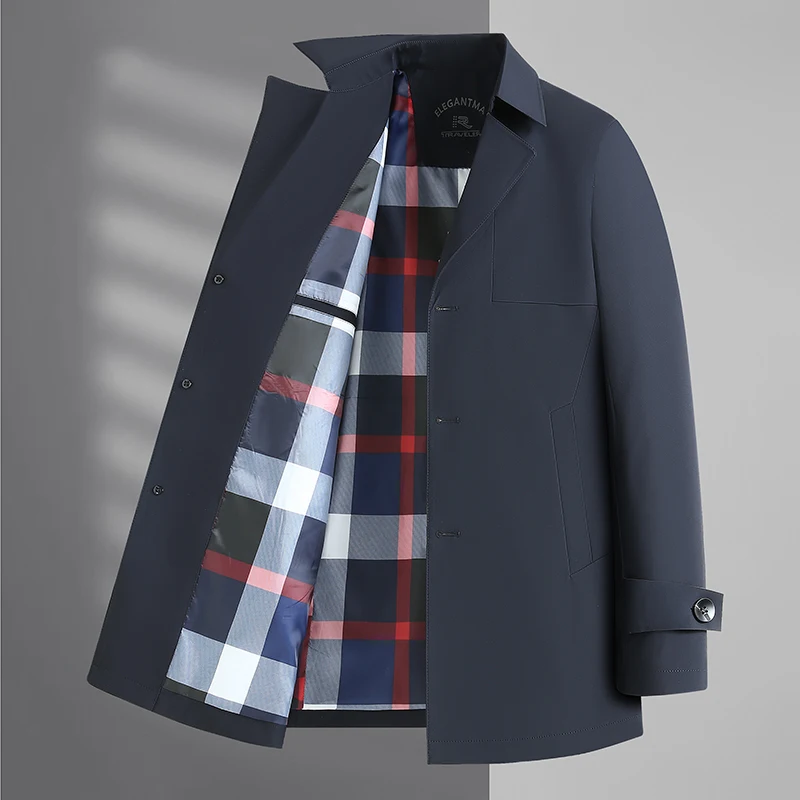
Climate Assessment:
– Cold, dry winters: Prioritize wool blends with cashmere in the 14-16 oz range
– Rainy, moderate climates: Consider water-resistant wool or cotton-blend options
– Mild conditions: Lighter cotton-wool blends or pure cotton topcoats (10-12 oz)
– Variable climates: Seek options with removable liners or innovative layering capacity
Style Compatibility:
– Business formal wardrobe: Traditional single-breasted designs in navy, charcoal, or camel
– Business casual emphasis: Consider more relaxed cuts with natural shoulders
– Primarily casual wear: Explore raglan sleeve options and less structured designs
– Varied wardrobe: Neutral colors and versatile designs that span dress codes
Practical Considerations:
– Travel frequency: Wrinkle-resistant fabrics and packable construction
– Storage limitations: Lighter-weight options that require less specialized storage
– Care preferences: Machine washable vs. dry-clean only requirements
– Budget priorities: Identify where to invest (fabric quality) vs. where to compromise
When trying on topcoats, wear or bring your typical underlayers to ensure proper fit. Focus on shoulder fit and sleeve length first, as these are more difficult and expensive to alter than simple length or waist adjustments.
For expert advice on maximizing your topcoat’s styling potential, explore our guide on maximizing your topcoat’s versatility. Remember that the perfect topcoat isn’t just about the coat itself—it’s about how seamlessly it integrates with your existing wardrobe and lifestyle needs.
Mastering the Art of Styling Your Light Topcoat
A well-chosen light topcoat serves as a versatile canvas for countless outfit combinations across different dress codes and occasions. The key to successful layering lies in understanding a few fundamental principles.
Core Layering Principles:
– Thin-to-thick progression: Start with lightweight base layers and increase thickness as you move outward
– Complementary colors: Create cohesive looks by working within a harmonious color palette
– Texture variation: Combine different textures (smooth wool with chunky knits) for visual interest
– Proportional balance: Ensure visible layers maintain appropriate proportion and exposure
Business Styling Formulas:
– Dress shirt + tie + wool suit + topcoat
– Dress shirt + fine merino sweater + unstructured blazer + topcoat
– Turtleneck + suit + topcoat
Smart Casual Combinations:
– Oxford shirt + light sweater + unstructured sport coat + topcoat
– Turtleneck + textured blazer + topcoat
– Fine gauge sweater + chinos + topcoat
Weekend Casual Options:
– Quality t-shirt + lightweight sweater + denim jacket + topcoat
– Henley + quarter-zip pullover + topcoat
– Chambray shirt + shawl cardigan + topcoat
Accessory Integration:
– Scarves: Lightweight options for style, heavier knits for added warmth
– Gloves: Consider both insulation and aesthetic coordination
– Hats: From dressy fedoras to casual beanies depending on overall outfit formality
For a polished appearance, consider how your topcoat length complements your height and build. Our guide on selecting the right coat length based on height provides tailored recommendations for optimal styling based on your specific proportions.
Remember that topcoat styling isn’t just about what goes underneath—it’s also about how you wear the coat itself. Leaving it open creates a more casual, layered look, while buttoning up presents a more polished, streamlined appearance.
Extending the Life of Your Light Topcoat
A quality topcoat represents a significant investment that can provide years of service when properly maintained. Different materials require specific care approaches to preserve their appearance and performance.
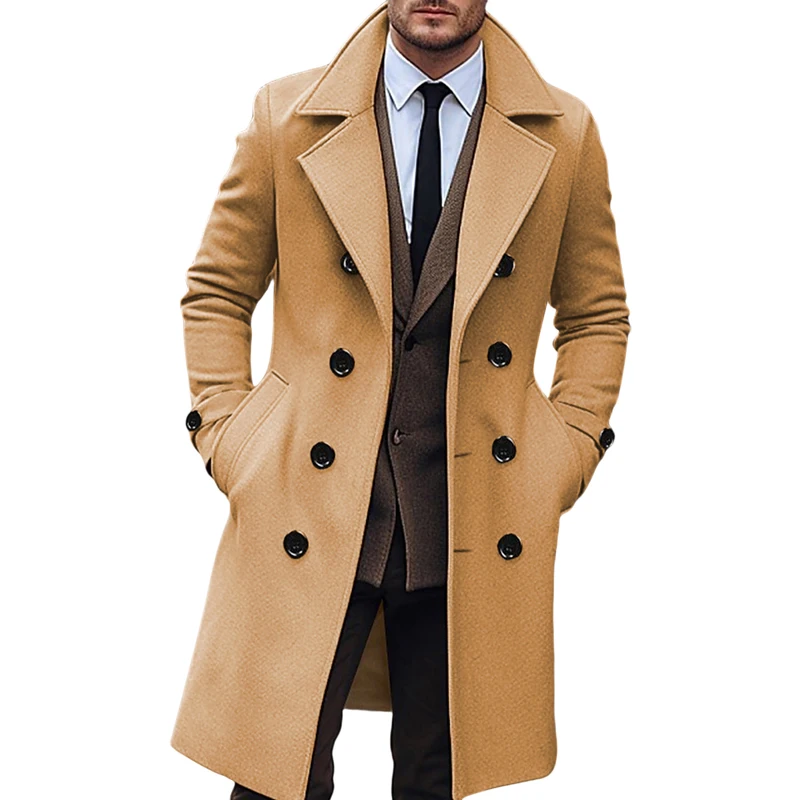
Material-Specific Care Guidelines:
– Wool and cashmere blends: Dry clean sparingly (1-2 times per season); use a clothes brush between cleanings; treat spots promptly with appropriate wool cleaner
– Cotton and cotton blends: Some may be machine washable (check labels); more structured versions require dry cleaning; spot clean when possible
– Technical fabrics: Follow manufacturer guidelines; many respond well to gentle machine washing and air drying
Proper Storage Essentials:
– Use wide, shaped wooden hangers that support the shoulders
– Allow space between coats in your closet to maintain shape and prevent creasing
– Store in breathable garment bags during off-season (avoid plastic)
– Place cedar blocks or other natural moth deterrents nearby for wool options
Seasonal Maintenance Routine:
1. Brush thoroughly with a quality clothes brush before storage
2. Address any spots or stains before they set
3. Ensure the coat is completely dry before storing
4. Consider professional cleaning at season’s end if heavily worn
Prevention Practices:
– Rotate between multiple coats when possible to reduce wear
– Use umbrella in heavy rain (even with water-resistant coats)
– Allow wet coats to dry naturally away from direct heat
– Address minor repairs (loose buttons, small tears) promptly
Mens Double Breasted Pea Coat, Mens Wool Blend Coat, Mens Wool Pea Coat
Price range: $136.84 through $157.36 Select options This product has multiple variants. The options may be chosen on the product pageMens Cashmere Overcoat, Mens Hooded Winter Coat, Mens Wool Blend Coat
Price range: $128.72 through $139.68 Select options This product has multiple variants. The options may be chosen on the product pageMens Black Overcoat, Mens Black Wool Coat, Mens Wool Overcoat
$339.18 Select options This product has multiple variants. The options may be chosen on the product pageMens Grey Overcoat, Mens Wool Blend Coat, Mens Wool Overcoat
$201.28 Select options This product has multiple variants. The options may be chosen on the product pageMens Herringbone Coat, Mens Long Overcoat, Mens Wool Overcoat
Price range: $197.16 through $203.69 Select options This product has multiple variants. The options may be chosen on the product pageMens Long Overcoat, Mens Topcoats
Price range: $189.40 through $196.88 Select options This product has multiple variants. The options may be chosen on the product page
Our collection of quality dress coats that complement your layering strategy includes options crafted with exceptional attention to detail and longevity in mind. With proper care, these investment pieces will serve as wardrobe foundations for many years.
Can Light Topcoats Provide Sufficient Warmth?
One common concern about lighter-weight topcoats is whether they can truly provide adequate warmth during colder weather. The answer lies in understanding the science of layering and insulation.
Light topcoats excel in the 40-65°F (4-18°C) range when properly layered. The key to warmth isn’t necessarily the weight of the outer layer but the air trapped between multiple thin layers. This trapped air serves as natural insulation, often providing more effective temperature regulation than a single heavy layer.
Effective base and mid layers that enhance topcoat warmth include:
– Merino wool base layers that wick moisture while insulating
– Cashmere sweaters providing exceptional warmth without bulk
– Insulating vests that warm the core while maintaining arm mobility
When temperatures drop below 40°F (4°C), strategic accessories become essential components of your layering system. A quality wool scarf not only adds style but also seals warmth around your neck, one of the body’s primary heat loss points.
For particularly cold conditions, heavier overcoats may become necessary. However, many men find that a well-layered light topcoat system provides sufficient warmth for daily activities like commuting and moving between heated environments. For more information about coat options suitable for various weather conditions, explore our guide to complementary information about coat options for transitional seasons.
Are Custom-Fitted Topcoats Better for Layering?
The question of ready-to-wear versus custom topcoats for layering merits careful consideration, particularly for those seeking optimal fit and performance.
Custom and made-to-measure topcoats offer distinct advantages for layering, primarily through precise adjustments in key areas:
– Sleeve width calibrated exactly to your layering preferences
– Chest and waist proportions balanced to your specific body shape
– Shoulder construction tailored to accommodate your typical underlayers
– Length optimized for your height and proportions
These benefits typically come with a 30-50% price premium over comparable ready-to-wear options. For many, this investment is justified by the perfect fit and elimination of alteration needs, particularly for men with non-standard proportions or specific layering requirements.
When communicating with a tailor about a layering topcoat, be explicit about your intended use. Bring your typical underlayers (suit jackets, heavy sweaters) to fittings, and discuss specific adjustment needs like higher armholes, slightly extended sleeves, or additional chest allowance.
For those with standard proportions, quality ready-to-wear topcoats with minor alterations often provide excellent layering performance at a lower price point. Our collection of additional overcoat options for versatile layering includes pieces designed with layering in mind, many requiring minimal alterations for ideal fit.
The optimal choice ultimately depends on your specific body type, budget priorities, and how precisely you need your topcoat to accommodate various layering scenarios.

